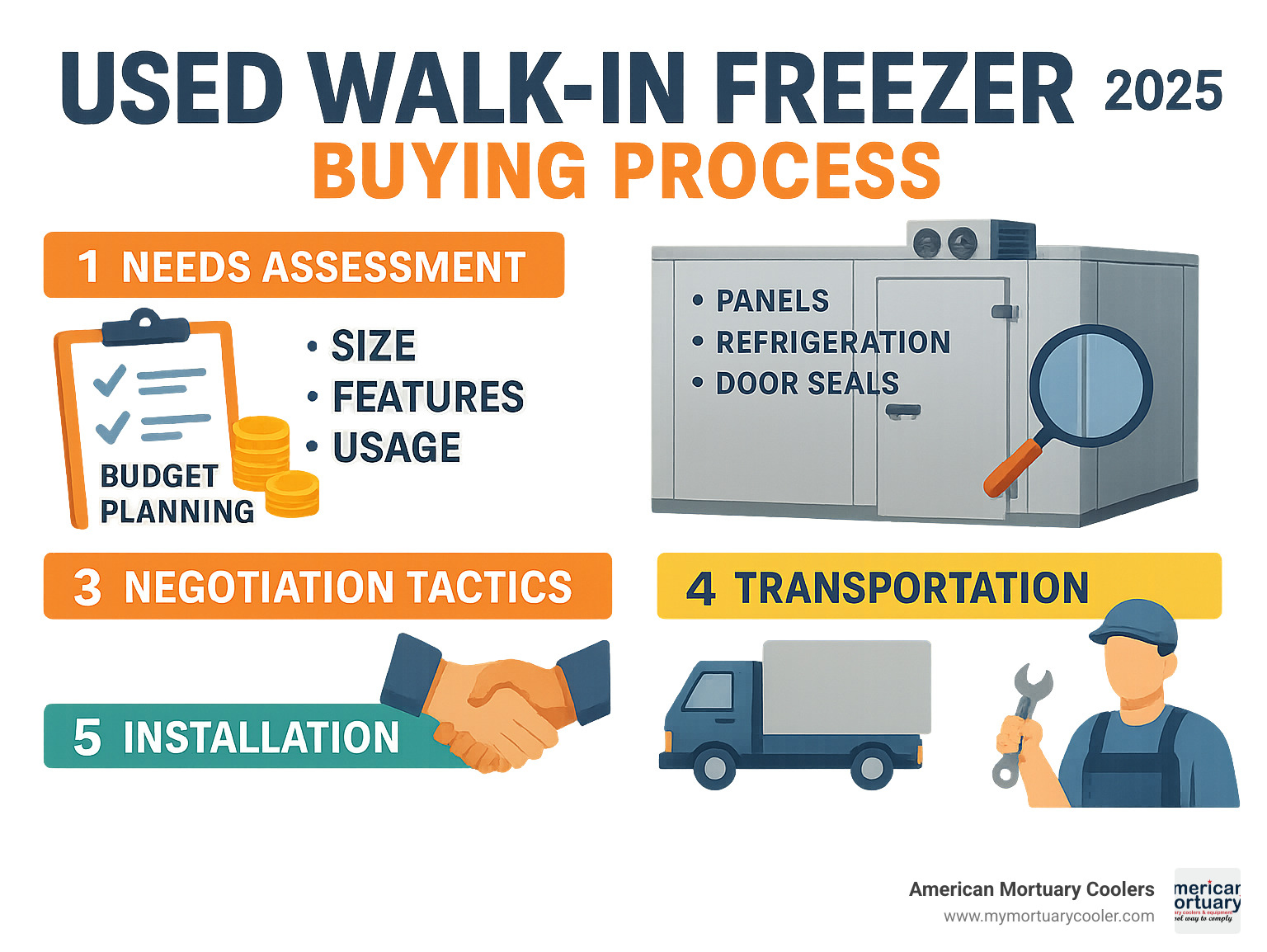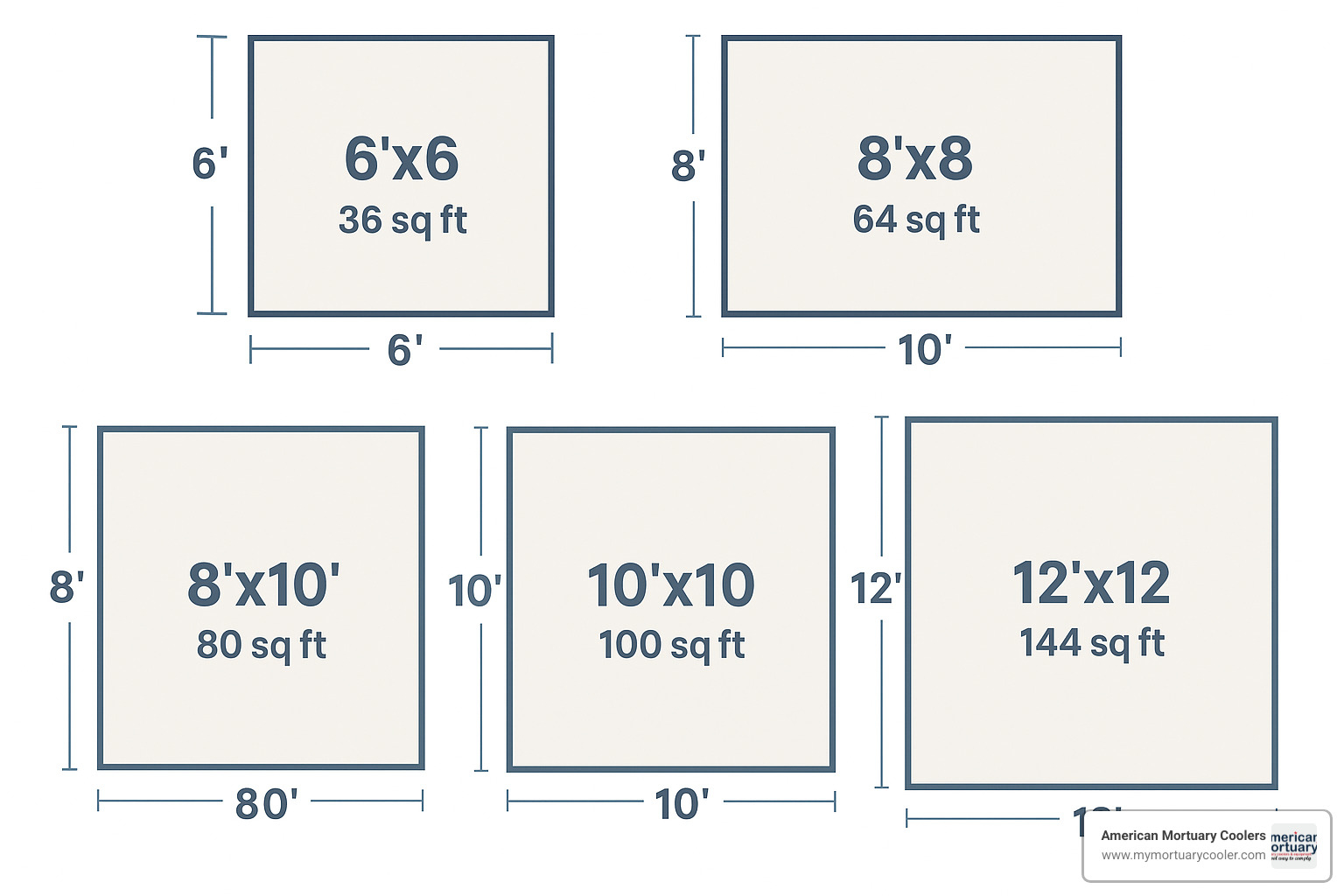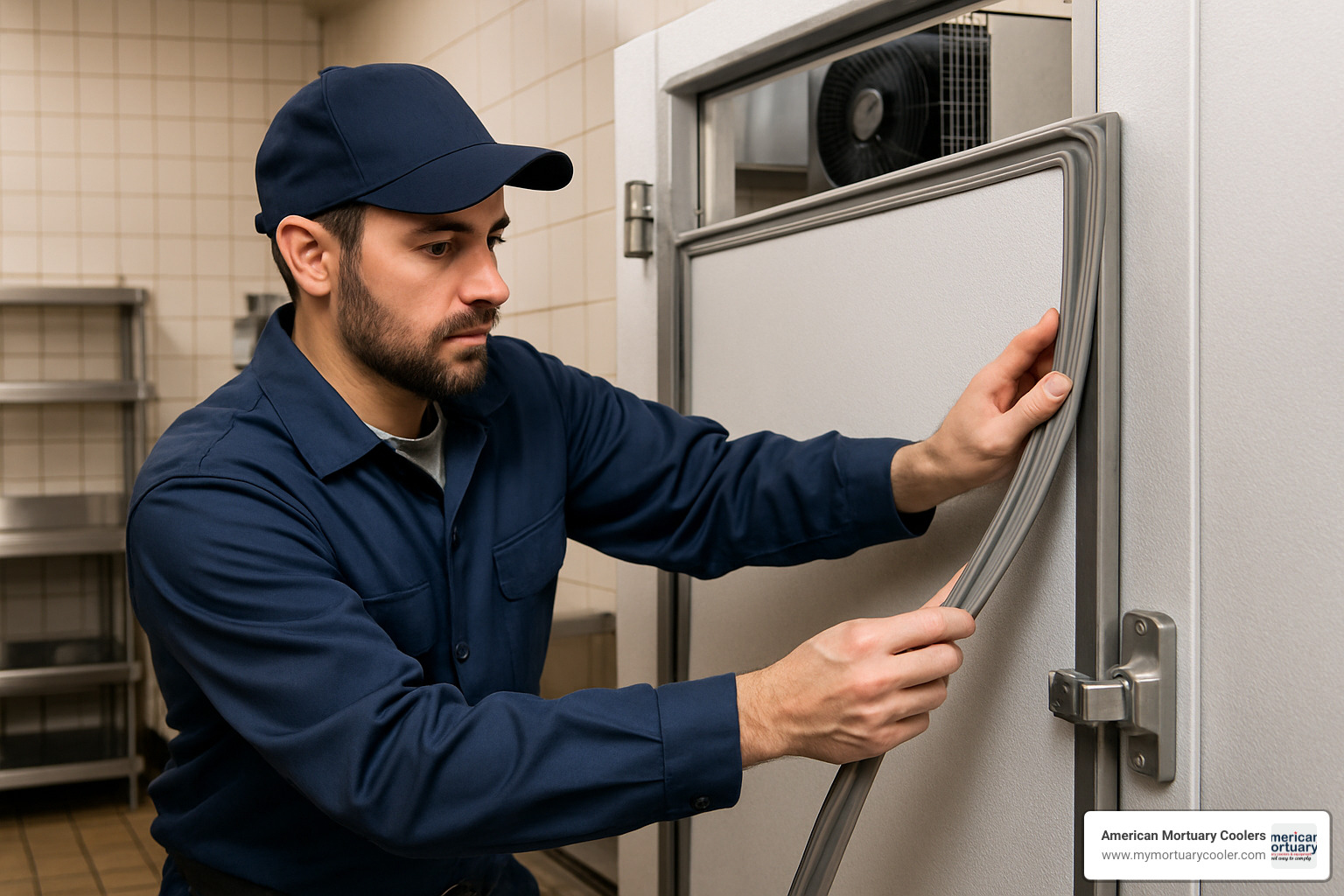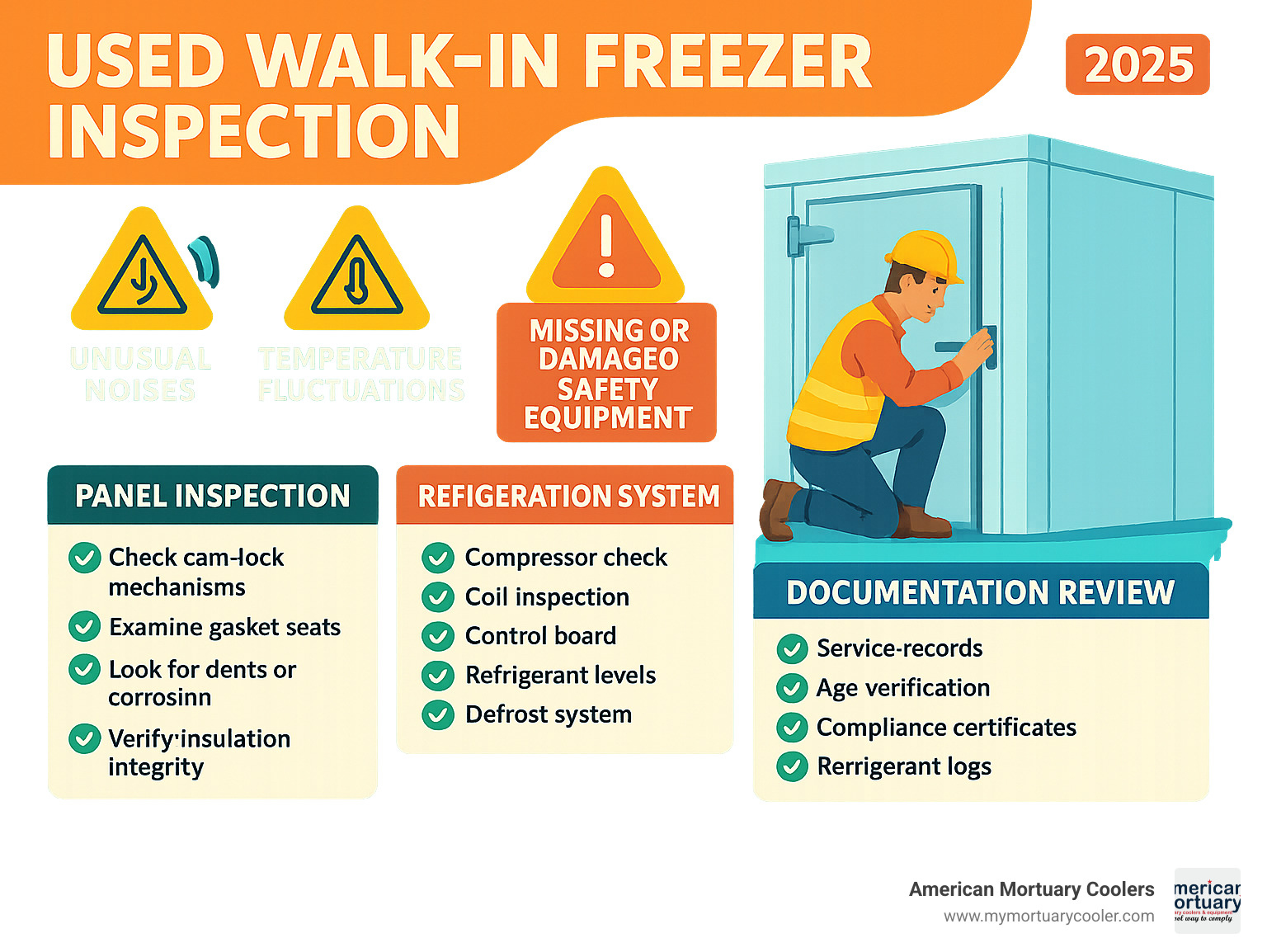
A Practical Guide to Buying a Used Walk In Freezer
Why Used Walk-In Freezers Are Gaining Popularity
A used walk in freezer can save your business 30-60% compared to new units while delivering the same reliable cold storage performance. Here's what you need to know:
Quick Overview:
- Price Range: $2,900-$25,000 (vs. $10,000+ for new)
- Common Sizes: 8'x8', 8'x10', 10'x10' most popular
- Top Brands: Kolpak, Nor-Lake, Amerikooler, Bally
- Operating Temperature: -10°F to -20°F standard
- Key Inspection Points: Panel condition, refrigeration system, door seals
- Best Sources: eBay (1,200+ listings), equipment dealers, auctions
Walk-in freezers provide large-scale temperature-controlled storage that smaller commercial freezers simply can't match. Unlike reach-in units, they offer walk-through access and can store massive quantities at consistent sub-zero temperatures.
The used market is robust - with over 1,200 used walk-in refrigerators and freezers listed on eBay at any given time. But buying used requires careful inspection and knowledge of what to look for.
Common buyer challenges include:
- Hidden damage in insulation panels
- Outdated refrigerant systems
- Missing warranty coverage
- Complex installation requirements
- Energy compliance issues
Smart buyers who know what to inspect can find reliable units that last 15-20 years with proper maintenance. The key is understanding the difference between a good deal and a costly mistake.
We're American Mortuary Coolers, a Tennessee-based specialist in custom refrigeration solutions with extensive experience helping businesses evaluate and source quality used walk in freezer equipment.

What Is a Walk-In Freezer & How Does It Differ From Other Commercial Freezers?
Think of a used walk in freezer as your own personal frozen warehouse. Unlike the reach-in freezer you might have in your restaurant kitchen, this is a room you can actually walk into - hence the name.
The magic happens at -10°F or colder. That's the industry benchmark that separates walk-in freezers from their cooler cousins. While walk-in coolers keep things chilled around 35°F, freezers maintain that rock-solid frozen temperature that keeps your inventory safe for months.
Here's what makes them different from reach-in units: Scale is the biggest factor. Your typical reach-in freezer gives you maybe 20-70 cubic feet of storage. A walk-in freezer? Even a modest 8'x8' unit provides 64 square feet of floor space, plus all that vertical storage on shelving.
The panel construction is where the real engineering happens. Quality walk-in freezers use modular panels - typically 4 inches thick with R-32 insulation value or higher. These panels lock together with a tongue-and-groove system secured by cam-locks, creating an airtight seal that keeps the cold in and the heat out.
You'll encounter two main compressor types when shopping used units. Self-contained systems have everything mounted on top of the freezer - convenient but can be noisy. Remote systems locate the condenser elsewhere, which is quieter but requires more complex installation.
Key Components Inside a Used Walk In Freezer
When you're inspecting a used walk in freezer, you're essentially evaluating six critical systems that work together to keep everything frozen solid.
Insulated panels form the backbone of the entire system. Look for 26-gauge steel exteriors with foamed-in-place insulation between the metal skins. The panels should fit together snugly with intact gasket seals - any gaps mean energy waste and potential temperature fluctuations.
Doors and gaskets get the most wear and tear since they're opened constantly. Personnel doors typically measure 34" x 78" with heavy-duty hinges and magnetic gaskets that create an airtight seal. Check that interior safety releases work properly - you don't want anyone trapped inside.
The evaporator is your internal air circulation system. This unit should have clean coils and proper defrost capabilities to prevent ice buildup. If the coils look like an ice sculpture, that's a red flag about maintenance history.
Your condenser unit removes heat from the system and needs adequate ventilation to work efficiently. Whether it's mounted on top or located remotely, make sure it's not clogged with debris or showing signs of refrigerant leaks.
Digital controllers have largely replaced old analog thermostats in modern units. These programmable systems manage temperature cycles, defrost timing, and alarm functions.
The defrost system prevents your evaporator from turning into an ice block. Systems use electric heat, hot gas, or water to clear ice buildup automatically. Without proper defrost cycles, your freezer becomes an expensive igloo.
For more detailed information about these components, check out our guide on everything you need to know about freezer walk-ins.
Why Choose a Used Walk-In Freezer?
Let's talk numbers first - because that's probably what brought you here. A used walk in freezer can slash your equipment costs by 30-60% compared to new units. We're talking about real money here: used models starting around $2,900 for smaller units, while new ones of similar size easily run $10,000 or more.
But the savings go beyond just the sticker price. When you buy new, you're often looking at 6-12 week lead times while your business waits. With used equipment, you can often have it installed and running within days or weeks.
There's also something to be said for proven performance. A unit that's been running reliably for several years has already passed the real-world test. You're not gambling on how well it will perform - you can see its service history and know what you're getting.
Of course, it's not all sunshine and savings. Used equipment comes with trade-offs you need to understand upfront. Limited warranty coverage is the big one - most used units offer 30-180 days maximum, compared to multi-year warranties on new equipment.
| Comparison Factor | New Walk-In Freezer | Used Walk-In Freezer |
|---|---|---|
| Purchase Price | $10,000-$40,000+ | $2,900-$25,000 |
| Lead Time | 6-12 weeks | 1-3 weeks |
| Warranty | 1-5 years | 30-180 days |
| Payback Period | 3-5 years | 1-2 years |
Benefits vs Downsides of a Used Walk In Freezer
The capital savings are obvious, but there's more to consider. When you spend less upfront, you're preserving cash flow for other business needs. A proven service history can actually be more valuable than a warranty. When you can see maintenance records showing a unit has run reliably for years, that tells you more about its future performance than any manufacturer's promise.
But let's be honest about the downsides. Limited warranty coverage means you're taking on more risk. Hidden damage is always a concern with used equipment. Insulation problems, refrigerant leaks, or worn components might not show up during a quick inspection but can cost thousands down the road.
Typical Price Ranges for a Used Walk In Freezer
The used market spans a wide range, from $2,000 to $25,000 depending on what you're looking for. Size is the biggest driver, but condition, features, and location all play a role.
Smaller units in the 6'x6' to 8'x8' range typically run $2,900-$8,000. Medium-sized units from 8'x10' to 10'x12' usually fall in the $6,000-$15,000 range. Larger units at 12'x12' and up can range from $12,000-$25,000 or more.
Several factors can push prices up or down significantly. Indoor versus outdoor installation makes a difference - outdoor units cost 20-30% more due to weatherproofing requirements. Floor inclusion adds $1,000-$3,000 to the price, but saves installation complexity.
Sizing, Brands & Configuration Checklist
Choosing the right size for your used walk in freezer can make or break your storage strategy. Most businesses find success with the "big three" sizes: 8'x8', 8'x10', and 10'x10' - they hit that sweet spot between storage capacity and floor space efficiency.
Here's the reality check: an 8'x10' unit gives you 80 square feet of floor space, which typically handles a restaurant serving 100-200 customers daily. But don't just think about today's needs - plan for where you'll be in 2-3 years.
Key sizing considerations include your delivery schedule, peak inventory periods, and the physical constraints of your space. Measure twice, buy once - especially for ceiling height, which is usually 7'7" or 8'7" standard.
The floor versus floorless decision adds another layer of complexity. Floor systems bump up the cost by $1,000-$3,000 but provide better insulation and easier cleaning.

Reputable Brands to Target
In the used walk-in freezer world, brand reputation isn't just about prestige - it's about parts availability and service support five years down the road. You want a brand that technicians know and parts suppliers stock.
Kolpak, Nor-Lake, and Amerikooler form the holy trinity of used walk-in reliability. These brands show up frequently in the used market because they build equipment that lasts long enough to have a second life. Bally built a reputation for robust construction - their units are tanks that keep running. Leer offers solid mid-range options, while American Panel and Crown Tonka round out the quality tier.
The brands to approach with caution? Any manufacturer that's gone out of business or uses proprietary components that require special-order parts.
Age matters differently for different brands. A 10-year-old Kolpak might be a better buy than a 5-year-old off-brand unit. Quality construction ages gracefully, while economy builds show their age quickly.
For a deeper dive into your options, check out our in-depth guide to walk-in freezer options.
Factors That Affect Used Walk In Freezer Price
Age gets all the attention, but it's not the whole story. Yes, a 10-year-old unit typically costs 50-70% less than something 2-3 years old, but a well-maintained older freezer can outperform a neglected newer one every time.
Panel condition tells the real story of a unit's life. Excellent condition means no dents, perfect gasket seals, and original finish intact. The refrigeration package drives both price and operating costs. A unit with a newer compressor, modern digital controls, and updated refrigerant commands premium pricing for good reason.
Location factors can add thousands to your total cost. An indoor unit that's easy to dismantle and load might cost $8,000. The same unit outdoors, requiring crane removal and cross-country shipping, could hit $12,000 total.
Energy efficiency ratings matter more than many buyers realize. A slightly more expensive unit with better insulation and efficient refrigeration can save hundreds annually in operating costs.
How to Inspect, Buy & Install a Used Walk-In Freezer
Buying a used walk in freezer without proper inspection is like buying a car without looking under the hood - you might get lucky, but you're probably setting yourself up for expensive surprises down the road.
The golden rule here is simple: never purchase without either seeing the unit run in person or getting rock-solid documentation of its current condition. Your pre-purchase checklist should cover the basics that separate a solid investment from a costly mistake.
The unit needs to reach and maintain -10°F consistently - not just get cold, but hold that temperature through normal door openings and defrost cycles. Visual inspection comes next, focusing on panels, doors, gaskets, and all refrigeration components for signs of wear, damage, or poor maintenance.
Red flags that should send you running include rust or corrosion on panels or refrigeration components, excessive ice buildup indicating defrost problems, unusual noises from the compressor or fans, temperature swings during operation, and missing or damaged safety equipment.

Step-By-Step Inspection Checklist for a Used Walk In Freezer
Think of this inspection like a medical exam for your potential freezer - you want to check every system methodically to avoid unpleasant surprises later.
Start with the panels, which are literally what hold everything together. Check those cam-lock mechanisms to make sure they engage properly - loose panels mean air leaks and energy waste. Examine gasket seals between panels for cracks, tears, or compression loss. Look over panel surfaces for dents, holes, or corrosion that could compromise insulation integrity.
Here's a pro tip: press gently on panel surfaces to check for soft spots or moisture intrusion. Damaged insulation feels spongy and means expensive repairs ahead.
The refrigeration system inspection requires more technical knowledge but covers the heart of your investment. Listen to that compressor - it should run smoothly without grinding, squealing, or excessive vibration. Examine both evaporator and condenser coils carefully. Excessive frost buildup on the evaporator suggests defrost system problems, while damaged fins or obvious leaks on either coil mean trouble.
Test all control board functions and watch for error codes that indicate system faults. Don't forget the refrigerant system - verify proper charge levels and check for signs of leaks around fittings and coils.

Door and safety checks might seem minor, but they're critical for both efficiency and code compliance. Test those magnetic gaskets thoroughly - poor seals waste energy and create temperature fluctuations. The interior safety release mechanism isn't just a nice feature - it's required by code and could save someone's life.
Ensuring Energy Efficiency & Compliance
Energy codes have gotten much stricter over the years, and what passed muster a decade ago might not meet today's requirements. EISA regulations now mandate R-32 insulation for freezer panels, which means some older units may need upgrades to comply with current codes.
The good news is that energy efficiency improvements often pay for themselves through reduced operating costs. LED lighting is a simple upgrade that cuts both energy consumption and heat load inside the freezer. Digital controls offer precise temperature management that reduces compressor cycling and energy waste.
Refrigerant considerations matter more than many buyers realize. R-448a is the modern replacement for the older R-404A refrigerant that's being phased out. Don't overlook compliance requirements that vary by location and application. Building permits are typically required for walk-in freezer installations.
For detailed cost breakdowns and compliance information, check out our complete guide to commercial walk-in freezer cost.
Transport, Installation & Maintenance Essentials
Moving a used walk in freezer isn't like relocating your home refrigerator - it's a complex process that requires professional expertise and careful planning. Professional dismantling ensures panels are properly labeled and protected during shipping.
Transport logistics matter more than you might expect. Lift-gate freight service is essential for heavy panel delivery unless you have loading dock facilities. Refrigerant recovery must be done by a certified technician before disassembly.
Installation requires licensed professionals for good reasons. HVAC contractors handle refrigeration connections safely and ensure proper system operation. The foundation needs to be a level concrete pad within 1/4 inch per 10 feet.
Ongoing maintenance keeps your investment running efficiently for years. Annual coil cleaning maintains peak efficiency and prevents premature component failure. Door gaskets typically need replacement every 2-3 years depending on usage.
When you need replacement parts, mywalkinparts.com offers comprehensive inventory for most major brands and models.
Warranties, Guarantees & Lifespan Estimation
Let's be realistic about warranties on used equipment - you're not getting the same coverage as new purchases. Most used equipment warranties range from 30-180 days, which is significantly less than the 1-5 year warranties on new equipment.
The real question isn't warranty length - it's realistic lifespan expectations. A well-maintained used walk in freezer from a quality manufacturer can deliver 15-20 years of total service life. Units with average maintenance typically last 10-15 years.
Several factors affect remaining useful life beyond just age. Original build quality matters enormously - premium brands like Kolpak and Nor-Lake typically outlast economy models by years. Here's the bottom line: a properly maintained unit from a quality manufacturer can provide 10+ years of reliable service even if it's already 5-7 years old when you buy it.
Where to Find Deals & Negotiate Smart
Finding the right used walk in freezer requires knowing where to look and when to buy. The secondary market is surprisingly robust, with thousands of units available across multiple channels.
eBay remains the largest marketplace, with over 1,200 walk-in refrigeration units listed at any given time. Equipment dealers offer a middle ground between new and completely used. Many specialize in refurbishing commercial refrigeration and provide limited warranties.
GovDeals auctions can be goldmines for budget-conscious buyers. Government facilities, schools, and hospitals regularly surplus equipment that's been well-maintained. Local sources like Facebook Marketplace and Craigslist let you inspect before buying.
Timing your purchase makes a significant difference in price. Winter months see less demand for refrigeration equipment, creating buyer-friendly conditions. Restaurant liquidations deserve special attention. When a food service business closes or relocates, they often sell complete kitchen packages.
For reference pricing, check current market options like this 8'x10' walkin freezer to understand what similar units are selling for.
Pro Tips for Negotiating the Best Price
Smart negotiation starts with thorough preparation. Document any issues you find during inspection and use them as leverage for price reductions or included repairs.
Shipping costs represent a major negotiation opportunity. Freight charges for a disassembled walk-in freezer can easily run $1,500-$3,000 depending on distance. Proposing to split these costs 50/50 often appeals to sellers.
Bundling additional items into the deal creates win-win scenarios. Ask the seller to include replacement gaskets, air filters, or basic maintenance supplies. Payment terms can be more flexible than you'd expect. Many sellers prefer net 30 payment or even installment arrangements over immediate cash.
Request a video of the unit running through a complete cooling cycle. This simple step proves operational status and can prevent costly surprises. Inspection contingencies should be standard in any agreement. Reserve the right to refuse the unit if it doesn't meet specifications upon delivery.
The key to successful negotiation is understanding that most sellers want a quick, hassle-free transaction. Positioning yourself as a knowledgeable, prepared buyer who can close quickly often matters more than being the highest bidder.
Frequently Asked Questions about Used Walk-In Freezers
When you're considering a used walk in freezer, you probably have some burning questions. Let's tackle the most common ones we hear from business owners who are weighing their options.
How long will a refurbished unit last?
Here's the honest truth: a professionally refurbished used walk in freezer from a reputable dealer can serve you well for 10-15 years with proper care. That's pretty impressive when you consider you're paying a fraction of the new price.
The secret sauce is in the details. Quality refurbishers don't just slap a fresh coat of paint on old equipment and call it good. They dig deep with new gaskets and seals, thoroughly clean and test the refrigeration systems, update controls when needed, and handle any structural repairs.
But here's what really matters: the original build quality and how old the unit was when it got refurbished. A 5-year-old Kolpak that's been well-maintained? That's going to outlast a 12-year-old no-name brand that's been through the wringer.
Can I convert a used cooler into a freezer?
Technically, yes - but it's like trying to turn a pickup truck into a race car. Possible? Sure. Smart? That's another story.
The insulation upgrade alone is a major undertaking. Freezers need R-32 insulation while coolers typically have R-25. You'll also need a beefier refrigeration system with different compressor sizing, freezer-specific controls for temperature and defrost cycles, and door modifications with heated frames to prevent ice buildup.
By the time you factor in all these changes, you're often looking at costs that approach buying a purpose-built used walk in freezer. Our advice? Start with what you actually need. If you need freezer storage, buy a freezer.
Do used units meet current health codes?
Most quality used walk in freezers will sail through health department inspections - but there's a big "if" attached. They need to maintain proper temperatures consistently and have NSF-compliant construction.
The good news is that reputable manufacturers like Nor-Lake, Kolpak, and Amerikooler built their units to last and meet standards. The key compliance factors are pretty straightforward: temperature maintenance at required levels, cleanable surfaces made from NSF-approved materials, proper safety equipment like interior releases and adequate lighting, and the right documentation including installation permits.
Before you pull the trigger on any purchase, have a quick chat with your local health department. They can tell you exactly what boxes you need to check.
Conclusion & Next Steps
Buying a used walk in freezer can transform your business operations while keeping thousands of dollars in your pocket. The 30-60% savings compared to new equipment isn't just attractive - it's often the difference between expanding your cold storage capabilities or waiting another year.
But here's the thing: success in the used market comes down to doing your homework. Thorough inspection prevents heartache later. That slightly damaged gasket or mysterious compressor noise you ignored during the initial viewing? It'll cost you far more in repairs and lost product than you saved on the purchase price.
The smart approach starts with knowing what you need. Measure your space carefully, calculate your actual storage requirements, and stick to reputable brands like Kolpak, Nor-Lake, or Amerikooler. These manufacturers have proven track records and - equally important - you can still get parts when something needs fixing.
Your next steps should follow this order: First, define your specific needs including size, budget, and timeline. Then research the market across multiple sources - don't just grab the first deal you see. When you find promising candidates, inspect them thoroughly or hire a qualified technician to do it for you.
Installation deserves professional attention. A properly installed used walk in freezer will serve you reliably for 10-15 years. Cut corners on installation, and you'll be dealing with temperature fluctuations, high energy bills, and premature equipment failure.
Don't forget the ongoing maintenance piece. Regular coil cleaning, gasket replacement, and temperature calibration aren't exciting, but they're what separate businesses that get decades of service from their equipment versus those replacing units every few years.
At American Mortuary Coolers, we've seen how quality refrigeration equipment performs when properly maintained. While our expertise focuses on custom mortuary coolers for funeral homes, the principles of reliable cold storage remain consistent across industries.
Before you make your final decision, verify these energy efficiency basics: R-32 insulation minimum, LED lighting, digital controls, modern refrigerant like R-448A, and ECM fan motors if available. These features will save you money every month on your electric bill.
The used market rewards patient, informed buyers. Take time to understand what you're looking at, negotiate from a position of knowledge, and plan for proper installation. A quality used walk in freezer becomes one of those purchases you feel good about for years - reliable performance at a price that didn't strain your budget.
Ready to dive deeper into walk-in freezer technology? Our comprehensive resource covers everything from basic operation to advanced troubleshooting: Everything You Need to Know About Freezer Walk-Ins.



